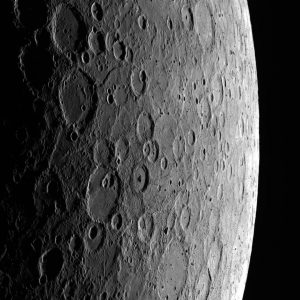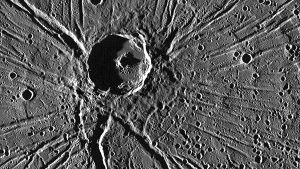Mercury is the planet closest to the Sun with an average distance of just 57.9 million kilometres. It is very hot and dry on the surface during the “day” where temperatures can reach over 420°C. When the sun finally sets on Mercury (after a staggering 176 days—explained later) the night-time temperature plunges to below -170°C.

Since Mercury is never more than 28° away from the sun in our sky, it is difficult to see; indeed, the most difficult of all the planets. It is visible for only a few days each month at dawn or dusk.
Mercury has many “firsts” in our planetary group. Aside from being closest to the sun, the most difficult to see, and having the greatest temperature range of all planets, it is the smallest, the fastest, has the smallest axial tilt (only 2° to the vertical), and the largest orbital inclination to earth (7°).
As the fastest planet, Mercury orbits the sun every 87.97 Earth days (as confirmed by the NASA Mariner X probe in 1974). That is a blistering speed of 48 kilometres a second. No wonder the ancient Romans named it after Mercury, their winged messenger of the gods. He of fleet foot with wings both on his helmet and shoes!
The 176 days of daytime is explained as follows. Because of the planet’s slow rotation combined with its high orbital speed means that it rotates on its axis roughly three times for every two orbits of the sun. This has the intriguing effect in that, from the surface of Mercury, the sun crawls across its sky setting only once every 176 earth days. And because Mercury has the smallest axial tilt of all the planets it has no seasons.
Mercury has virtually no atmosphere at all, and it is thought the planet lost most of it shortly after birth. It is hard to hold onto things when you have a low gravity, with Mercury barely 38% that of Earth. A 68kg person would weigh 25.8kg on Mercury (one could go there for a good weight loss programme!).
Gravity is indeed a major influence on a planet’s ability to hold onto its atmosphere. What little there is left (Mercury is essentially a vacuum) its atmosphere seems a bit of a mixed bag, depending on: where you look (at the equator, polar region, or at altitude); and, when you look (in terms of orbital position and distance from the sun).
Aside from its problems with gravity Mercury also has a very weak magnetic field, so it has very little protection against the solar wind. The sun’s radiation strips varying amounts of atmospheric components from Mercury so the mix can change seasonally too (as the planet’s solar distance changes). For what it’s worth various observations seem to suggest the atmosphere contains sodium, calcium and magnesium with traces of hydrogen, helium and potassium.
As mentioned, Mercury has a weak magnetosphere so that it has very little protection against the solar winds. The Messenger probe (the first spacecraft ever to orbit the planet–2005) revealed the planet had a tail-like comet, about two million kilometres in length, which contained sodium and calcium. Perhaps the sun’s radiation is constantly stripping Mercury of these elements.
Of all the planets, Mercury’s orbit is the most eccentric—a 50% difference: at its nearest point to the sun (perihelion) it is 46 million kilometres away; at its furthest point (aphelion) it is 69.4 million kilometres away. Its atmospheric composition may well vary considerably between these two extremes in distance, given the planet’s very weak magnetic field, and the varying force of the solar winds.

For most of its 4.6 billion years history Mercury has been pummelled by asteroids and meteors, so it is heavily cratered. Mariner X mapped its surface in 1974 to show a very rough, weird surface because of craters and reaction to multiple impacts. A meteor impact tends to cause an upsurge of rocks and mountains on the opposite side of a planet—the so-called antipodal point, being diametrically opposite to the point of impact. It is similar to the concept of “contra coup” injury of the brain: where the injury to the side of the brain opposite the site of impact is also injured, often more seriously.
As we said, Mercury does not have enough gravity to hold onto its atmosphere, so it gets fairly walloped by meteors. The Caloris Basin is an impact crater of a staggering 1 350km in diameter; staggering because that is almost 10% of the planet’s circumference. On Earth the United Kingdom would fit in Caloris with room to spare.
Mercury has a lunar-like crust with crustal faulting, and its surface looks almost colourless, sort of a dull lead. It is thought that volcanic action continued up until a billion years ago, which added further features to its surface. As the axis of Mercury is almost vertical, so the insides of polar craters remain in shadow allowing for ice to form.
The planet’s diameter at the equator is 4 875 kilometres, the smallest of the planets. Mercury has a huge solid iron core of about 2 000 kms in diameter (according to Nasa’s Messenger probe), an outer molten core of about 800 kilometres thick, and a crust of about 635 kilometres thick, consisting mainly of anorthosite, similar to the lunar highlands.
Back to Top
By Nigel Benetton, science fiction author of Red Moon Burning and The Wild Sands of Rotar
Last updated: Tuesday, 28th January 2020